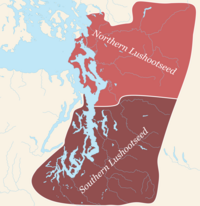List of Lushootseed-speaking peoples
This is a list of Indigenous peoples who speak, or historically spoke, the Lushootseed language. Lushootseed-speaking groups were traditionally politically autonomous at the local, or village, level, so there is no one term to unite all Lushootseed-speaking peoples.[1] Words like (dxʷ)ləšucid ʔacʔaciɬtalbixʷ or ʔacʔaciɬtalbixʷ kʷi gʷədxʷləšucideb (lit. "Lushootseed peoples" or "Peoples who speak Lushootseed") are sometimes used in modern times.[2] Sometimes, anthropologists have grouped all Lushootseed-speaking peoples together as the "Lushootseed people."[3] All historically-attested extended village groups or bands are listed, grouped by modern-day tribal units, sub-units, and further sub-units.
Northern Lushootseed[edit]
Northern Lushootseed (dxʷləšucid)[4] is spoken by peoples living generally in Island, Skagit, Snohomish, and parts of Whatcom counties. Northern Lushootseed-speaking communities include:
- Upper Skagit - sqaǰətabš[4]
- Sauk - saʔqʷəbixʷ[6]
- Suiattle - suyaƛ̕bixʷ[6]
- Stillaguamish - stuləgʷabš[4]: 230
- Quadsack - qʷacaʔkʷbixʷ
- Swinomish - swədəbš[4]: 246
- Squinamish - sqʷədəbš[4]: 190
- Kikiallus - kikiyalus[4]: 119
- (Lower) Skagit - sqaǰətabš[4]
- Snohomish - sduhubš[4]
Southern Lushootseed[edit]
Southern Lushootseed, otherwise known as Twulshootseed (txʷəlšucid)[7] is spoken by the various peoples, historical and contemporary, located in King, Pierce, Thurston, Mason, and Kitsap counties. Southern Lushootseed communities include:
- Skykomish - sq̓ixʷəbš[4]
- Staktalijamish - st̕aq̓taliǰabš[4]
- Upper Skykomish/Index people - bəsx̌əx̌əx̌əlč
- Duwamish - dxʷdəwʔabš[4]
- Suquamish - dxʷsəq̓ʷəbš[8]
- Saktamish - sx̌aq̓tabš
- Puyallup - spuyaləpabš[4]
- Hylebos Creek band - sx̌ax̌ƛ̕abš[9]
- Clarks Creek band - txʷskʷaqʷabš
- Simons Creek band - sqʷədabš
- Homamish - sxʷəbabš[10]
- Shotlemamish - dəxʷsx̌əƛ̕əbabš
- Steilacoom - č̓tilqʷəbabš[4][9]
- Clover Creek band
- Nisqually - dxʷsqʷaliʔabš[4][11]
- Sequalitchew - sčəgʷaličabš
- Lower Nisqually
- Clear Creek band
- Nisqually Lake band
- Muck Creek band
- Meshal/Mashel - bəšalabš[9]
- Squaxin Island - sqʷax̌sədəbš[4][12]
Whulshootseed[edit]
Whulshootseed (xʷəlšucid) refers to the large subdialect of Southern Lushootseed spoken by the Snoqualmie and Muckleshoot peoples.
- Snoqualmie - sdukʷalbixʷ[4]
- Muckleshoot - bəqəlšuɬ[4]
See also[edit]
References[edit]
- ^ a b c d e f Collins, June M. (1974). Valley of the Spirits: The Upper Skagit Indians of Western Washington.
- ^ Waterman, T.T. (2001). sdaʔdaʔ gʷəɬ dibəɬ ləšucid ʔacaciɬtalbixʷ - Puget Sound Geographical Names. Seattle: Lushootseed Press.
- ^ Miller, Jay (1997). "Back to Basics: Chiefdoms in Puget Sound". Ethnohistory. 44 (2): 375–387. doi:10.2307/483373. ISSN 0014-1801.
- ^ a b c d e f g h i j k l m n o p q r s t u v w x y z aa ab ac ad ae af ag ah Bates, Dawn; Hess, Thom; Hilbert, Vi (1994). Lushootseed Dictionary. Seattle: University of Washington Press. ISBN 0-295-97323-4.
- ^ Richardson, Allan; Galloway, Brent (2011). Nooksack Place Names: Geography, Culture, and Language. Vancouver: UBC Press.
- ^ a b "Sauk-Suiattle - Index". sauk-suiattle.com. Retrieved September 24, 2023.
- ^ "Puyallup Tribal Language - Home". www.puyalluptriballanguage.org. Retrieved September 24, 2023.
- ^ "The Suquamish Tribe – Home of the Suquamish People". Retrieved September 24, 2023.
- ^ a b c Smith, Marian W. (1941). "The Coast Salish of Puget Sound". American Anthropologist. 43 (2): 197–211 – via JSTOR.
- ^ Hutchinson, Chase (March 1, 2021). "Estuary has new name, honoring tribe; you'll need to watch a video to pronounce it". The News Tribune. Retrieved September 24, 2023.
- ^ ":: Nisqually Indian Tribe Home Page". www.nisqually-nsn.gov. Retrieved September 24, 2023.
- ^ a b c d e f "Who We Are – Squaxin Island Tribe". Retrieved September 24, 2023.
- ^ a b c Tollefson, Kenneth D. (1987). "The Snoqualmie: A Puget Sound Chiefdom". Ethnology. 26 (2): 124 – via JSTOR.

